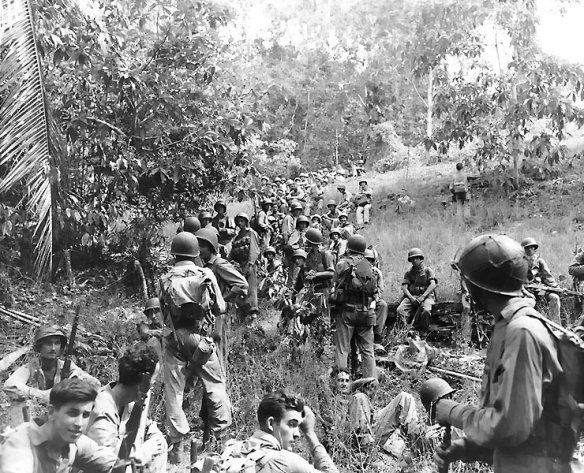
United States Marines rest in the field during the Guadalcanal campaign. According to Ken Burns’ film The War, the Marine in the right background is Sidney Phillips of Mobile, Alabama. Another source dates this photo to 8/8/42, and identifies the reclining Marine with hands behind head as “Bill Coggin”
Bitter contest between the Japanese and the Americans that marked a turning point in the Pacific war. The struggle on Guadalcanal was protracted, and the period from August 1942 to February 1943 saw some of the most bitter fighting of the war. In all, there were some 50 actions involving warships or aircraft, 7 major naval battles, and 10 land engagements.
Guadalcanal is an island in the Solomon chain northeast of Australia. It lies on a northwest-southeast axis and is 90 miles long and averages 25 miles wide. Guadalcanal’s southern shore is protected by coral reefs, and the only suitable landing beaches are on the north-central shore. Once inland, invading troops faced dense jungle and mountainous terrain, crisscrossed by numerous streams. The Guadalcanal Campaign encompassed not only Guadalcanal, but Savo and Florida Islands as well as the small islands between Florida and Guadalcanal: Tulagi, Tanambogo, and Gavutu.
In January 1942, Japanese amphibious forces had landed in the Bismarck Archipelago between New Guinea and the Solomon Islands. They quickly wrested Kavieng on New Ireland Island and Rabaul on New Britain from the Australians. The Japanese consolidated their hold and turned Rabaul into their principal southwest Pacific base. By early March, the Japanese landed at Salamaua and Lae in Papua and on Bougainville. Their advance having gone so well, the Japanese decided to expand their defensive ring to the southeast to cut off the supply route from the United States to New Zealand and Australia. On 3 May, the Japanese landed on Tulagi and began building a seaplane base there. Between May and July, the Japanese expanded their ring farther in the central and lower Solomons. These operations were carried out by Lieutenant General Imamura Hitoshi’s Eighth Army from Rabaul. The first Japanese landed on Guadalcanal on 8 June. On 6 July, their engineers began construction of an airfield near the mouth of the Lunga River.
The discovery of the Japanese effort on Guadalcanal led to the implementation of Operation WATCHTOWER. Conceived and pushed by U.S. Chief of Naval Operations Admiral Ernest J. King, it called for securing Tulagi as an additional base to protect the United States–Australia lifeline and as a starting point for a drive up the Solomons to Rabaul. On 1 April 1942, the Pacific was divided into two commands: U.S. Vice Admiral Robert L. Ghormley, commanding in the South Pacific, was to take the southern Solomons including Guadalcanal, and General Douglas MacArthur’s forces were to secure the remainder of the Solomons and the northwest coast of New Guinea, the final objective being Rabaul.
If the Japanese were allowed to complete their airfield on Guadalcanal, they would be able to bomb the advanced Allied base at Espiritu Santo. U.S. plans to take the offensive were now stepped up, and a task force was hurriedly assembled. From Nouméa, Ghormley dispatched an amphibious force under Rear Admiral Richmond K. Turner, lifting Major General Alexander A. Vandegrift’s 19,000-man reinforced 1st Marine Division. A three-carrier task force under Vice Admiral Frank J. Fletcher provided air support. This operation involved some 70 ships.
On 7 August 1942, the Marines went ashore at Tulagi, Florida, Tanambogo, Gavutu, and Guadalcanal, surprising the small Japanese garrisons (2,200 on Guadalcanal and 1,500 on Tulagi). On the same day, the Marines seized the harbor at Tulagi, and by the next afternoon they had also secured the airfield under construction on Guadalcanal, along with stocks of Japanese weapons, food, and equipment. Supplies for the Marines were soon coming ashore from transports in the sound between Guadalcanal and Florida Islands, but this activity came under attack by Japanese aircraft based at Rabaul. Vandegrift told Fletcher he would need four days to unload the transports, but Fletcher replied that he was short on fuel and in any case could not risk keeping his carriers in position off Guadalcanal for more than 48 hours.
Stakes were high for both sides. The fiercest fighting occurred for the airfield, renamed Henderson Field for a Marine aviator killed in the Battle of Midway. Vandegrift recognized its importance and immediately established a perimeter defense around it. Eating captured rations and using Japanese heavy-construction equipment, the U.S. 1st Engineer Battalion completed the airfield on 17 August. As early as 21 August, the day the Japanese mounted a major attack on the field, the first U.S. aircraft landed there. The Japanese now found it impossible to keep their ships in waters covered by the land-based American aircraft during the day, and they found it difficult to conduct an air campaign over the lower Solomons from as far away as Rabaul.